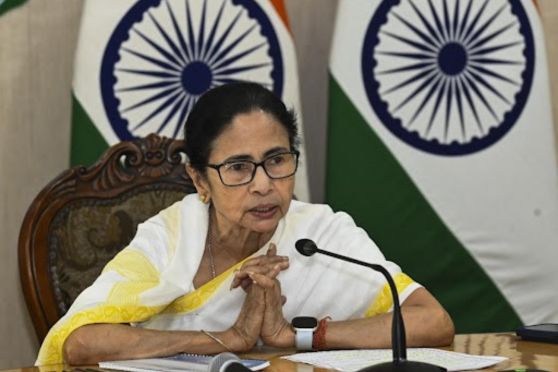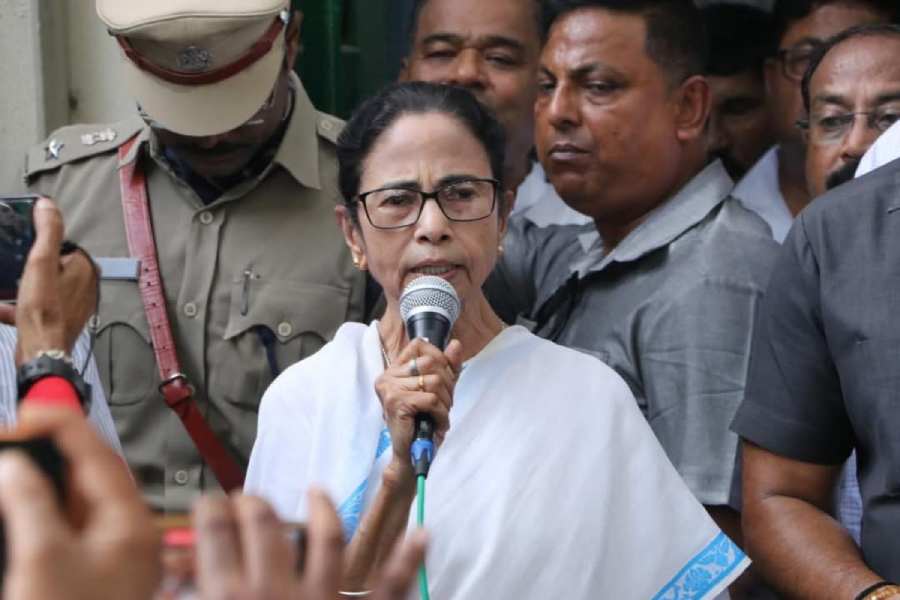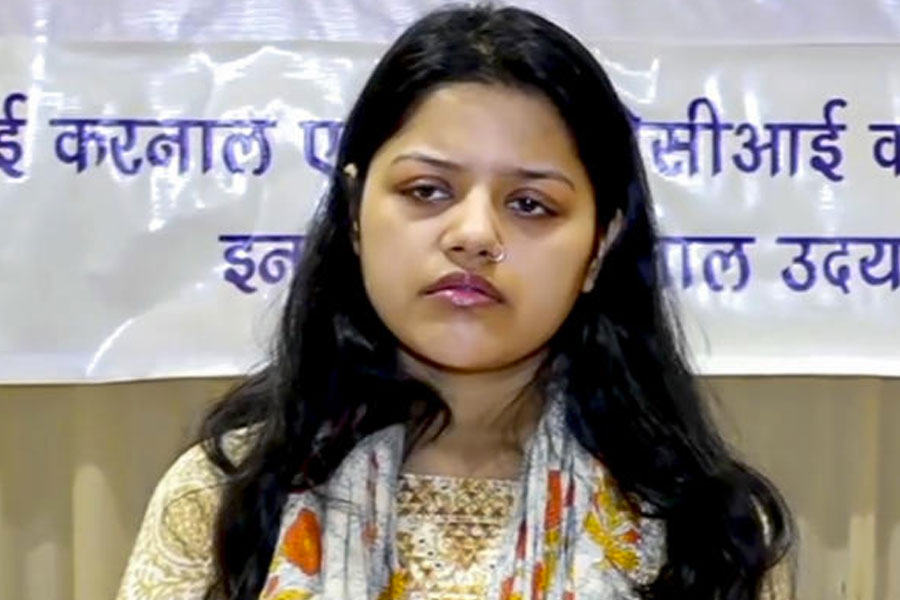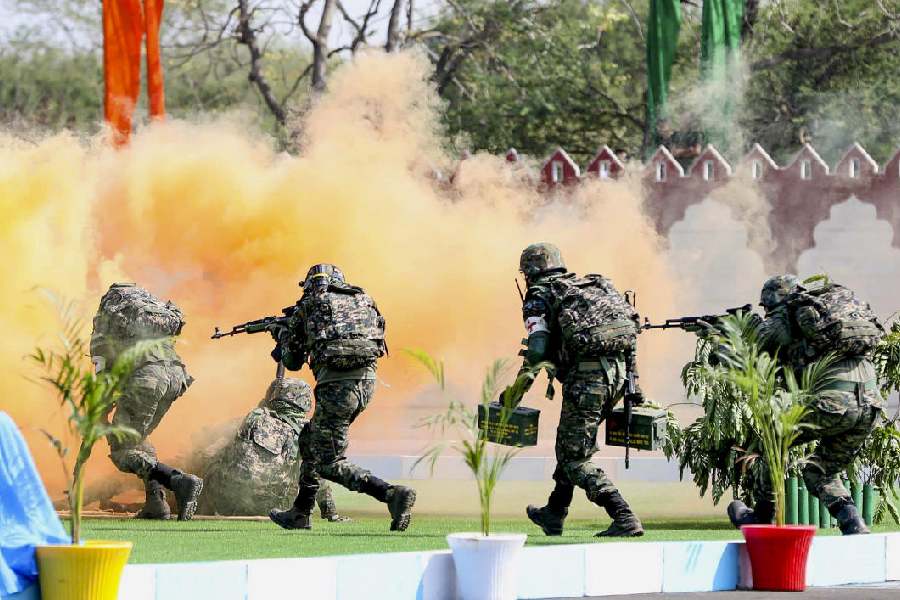|
|
| Grand decay |
Workmen are busy almost round the clock on an already grand private dwelling down the road from where I live. What miracles are being wrought inside I don’t know but I watched fascinated as the outside wall was carefully remodelled. The pebbled effect wasn’t obtained readymade from a factory: a mistry chose each large pebble from a pile, set it in the groove he had already filled with cement and then slowly hammered it home. Given the length of the wall — about 50 ft — and its height of some 8 ft, I was reminded of Lewis Carroll’s “‘If seven maids with seven mops/ Swept it for half a year,/ Do you suppose,’ the Walrus said,/ ‘That they could get it clear?’”
Walking around the decaying central business district an hour or so earlier, I had chanced upon two bold bright notices in Bengali bearing the Calcutta Municipal Corporation’s imprimatur. Under the heading, “Warning”, they announced that a building was unsafe. The plaster had flaked off, saplings sprouted from crevices between the powdery red bricks, blistered doors and windows hung askew. That held no surprise, for houses also live and die. What would have been remarkable anywhere but in Calcutta was that this wreck was not abandoned. Fans whirred inside, an occasional naked electric bulb twinkled in the gloom where people could be seen moving about. Not only would they be killed if the building lived up to its promise and collapsed, but the debris would overwhelm pavement hawkers and pedestrians in that narrow lane running off Bentinck Street. But who cares?
Perhaps the contrast between the two scenes made a greater impression on me because I had returned only the night before. Even a week’s absence is enough to forget what a ruin the city is. Moreover, I do not often amble among the ghosts of Hamilton, Cuthbertson and Harper, Phelps and Cooke and Kelvey. They are persistent ghosts, and I had felt their pull nearly 60 years ago when I suddenly came upon what I thought was the Royal Insurance Building at the corner of Dalhousie Square and Koilaghat Street, but in faraway Manchester. It was not until much later, by when Irish terrorists had destroyed the Mancunian edifice, that I learnt that this Edwardian brick building had been designed to look perfectly at home in the financial centres of London, Manchester, Birmingham, Belfast and, of course, Calcutta. Now, the Calcutta version is as much a spectre as the North British Building further up on the road where Subhas Chandra Bose has edged out Robert Clive.
The Great Eastern Hotel is not a ghost but a rotting corpse. Under its arcade, or possibly next door, I was startled to see, beyond piles of cheap readymades selling on the pavement, a once familiar name on a grubby plate glass window that still held some dusty, yellowed dog-eared books. I remember dressing up Newman’s window 27 years ago with copies of my own book, Smash and Grab: Annexation of Sikkim, all round a large framed map titled, “The Kingdom of Sikkim”. I draped a white silk scarf over the frame and topped the whole with a Tibetan lama’s dance mask. Newman’s proprietor telephoned a few days later to say more people wanted to buy the map and mask than the book!
The contrast between the opulent renovation of the private mansion in Ballygunge and the death throes of that block of flats near Dalhousie Square says much about the Calcutta Mamata Banerjee has inherited. Other lavish private villas in Ballygunge and Alipore remind us that money was made in this city all through the supposedly arid 34 years of Left Front rule. It is still being made. But the decrepitude at the heart of Calcutta points to the disconnect between a dying city and those who continue to flourish in it. Ms Banerjee’s announcement of investment proposals for Rs 56,000 crores need not, therefore, be greeted with whoops of joy. Privately-run hospitals, nursing homes, schools, clubs and welfare organizations are money-spinners for shrewd entrepreneurs, even more so when they are camouflaged as charities and trust or devattar undertakings. The owners pay few taxes and contribute little to general welfare. Everyone knows how they got away with it under the Left Front. The Trinamul Congress should not replicate that unholy collusion. Instead, a case can be made out for a graded system of taxation — I hesitate to say poll tax because of its unhappy historical associations — for those who earn handsomely to pay for urban renewal. That would not violate the Trinamul’s promise not to introduce water tax.
There’s so much to be done by way of repair and restoration. Roads, housing, transport, police, water, pollution, health, waste disposal and, above all, restoring a crumbling infrastructure. A major reason for neglecting maintenance is that unless you are very brash (like a former governor who erected a marble plaque in Raj Bhavan in tribute to himself and his ‘first lady’), you can’t put up self-glorifying notices every time a building is painted or parks are weeded. New statuary, new parks, new walkways permit that grab at posterity’s attention, which is why projects are so often abandoned once the initial publicity has been squeezed out of the inauguration.
Whoever created Curzon Park might have claimed our gratitude if rulers in those days hankered after publicity like today’s politicians. We know who destroyed the park, cutting it up into segments and relentlessly turning each into a wasteland. The Curzon Park I had to trample through in my search for a tram is a metaphor for Calcutta. But it’s shortsighted to imagine that there is no dividend in restoring it to a semblance of its earlier beauty. Fences need to be removed or repaired, broken tarmac replaced, unnecessary paths blocked off, new benches provided, the grass relaid and tended, a firm moratorium placed on new statues even if some of the hideous existing structures can’t be removed, and bus routes and tramlines diverted. There must be a moratorium, too, on “beautification”, such as fountains whose railings provide hawkers with cost-free display facilities. And no public meetings either.
My tram rattled and shuddered in at last and that, again, was another metaphor for confusion and negligence. Do we want trams or do we want to phase them out? If the latter, why keep up the pretence with a few derelict cars? If the former, why do even Calcutta Tramways Corporation employees in ragged khaki point to the row of parked white CTC buses for me to take? A tramway company running a bus service is surely an admission of failure. It was announced recently that the two tram coaches would be uniform, meaning belated official admission of the so-called First Class being levelled down. Equality in some societies means raising the bottom; in others, it’s a euphemism for dragging down the top.
Asian Development Bank loans and Jawaharlal Nehru National Urban Renewal Mission funds alone cannot work miracles. Nor will the trickle-down effect (compared to feeding horses with oatmeal so that sparrows can feast in the dung) from investment, though, admittedly, it is needed to generate employment. The problem is that six months after the Trinamul assumed power, there is still little evidence of a comprehensive overall strategy that goes beyond populist declarations of intent and is backed by a team of competent officers. Sycophants, political or bureaucratic, and a clique of ‘intellectual’ advisers won’t achieve administrative efficiency or purge the administration of corruption. Central funds are pocketed while patchwork repairs using sub-standard material means that potholes return to roads every monsoon.
In the race for the chief ministership, Ms Banerjee showed herself as a person with a vision. As chief minister, she has yet to demonstrate she has the ability to turn vision into reality.











